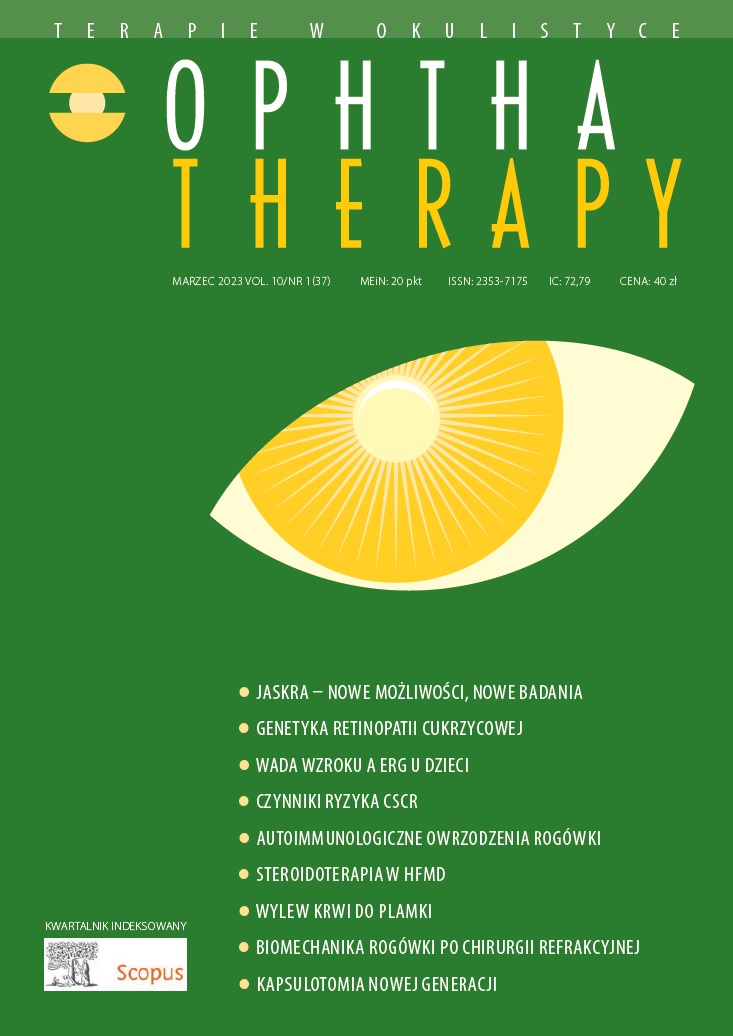The association Between ALR2 -106C>T Gene Polymorphisms and Diabetic Retinopathy Susceptibility In Diabetes Mellitus Patient: A Systematic Review and Meta-Analysis Meta-Analysis
Main Article Content
Abstract
Aldose reductase gene polymorphisms has been indicated to be associated with diabetic retinopathy (DR). The research data were from PubMed and EMBASE. We identified -106C > T single nucleotide polymorphism (SNP). Pool odds ratio (OR) with 95% CI were calculated. Nine studies were included. ALR2 106C > T gene polymorphisms was associated with the increased risk of DR in T1DM (C vs. T, OR = 2.07, p = 0.001; CC vs. CT + TT, OR = 2.56, p = 0.005). T allele and TT genotype were associated with decreased risk of DR in T1DM (OR = 0.48, p = 0.0001 and OR = 0.12, p = 0.0005). In conclusion, C allele and CC genotype may be a risk factor, while T allele and TT genotype may serve as protective factor for DR in T1DM patient.
Downloads
Article Details

This work is licensed under a Creative Commons Attribution-NonCommercial-NoDerivatives 4.0 International License.
Copyright: © Medical Education sp. z o.o. License allowing third parties to copy and redistribute the material in any medium or format and to remix, transform, and build upon the material, provided the original work is properly cited and states its license.
Address reprint requests to: Medical Education, Marcin Kuźma (marcin.kuzma@mededu.pl)
References
2. Thomas RL, Halim S, Gurudas S et al. IDF Diabetes Atlas: A review of studies utilising retinal photography on the global prevalence of diabetes related retinopathy between 2015 and 2018. Diabetes Res Clin Pract. 2019; 157: 107840.
3. Tarr JM, Kaul K, Chopra M et al. Pathophysiology of Diabetic Retinopathy. ISRN Ophthalmol. 2013; 2013: 1-13.
4. Robinson WG, McCaleb ML, Feld LG et al. Degenerated intramural pericytes (?ghost cells? in the retinal capillaries of diabetic rats. Curr Eye Res. 1991; 10(4): 339-50.
5. Chung SSM, Chung SK. Genetic Analysis of Aldose Reductase in Diabetic Complications. Curr Med Chem. 2003; 10(15): 1375-87.
6. Hamada Y, Nakamura J, Naruse K et al. Epalrestat, an Aldose Reductase Inhibitor, Reduces the Levels of N? (Carboxymethyl)lysine Protein Adducts and Their Precursors in Erythrocytes From Diabetic Patients. Diabetes Care. 2000; 23: 1539-44.
7. Graham A, Heath P, Morten JEN et al. The human aldose reductase gene maps to chromosome region 7q35. Hum Genet. 1991; 86(5): 509-14.
8. Aida K, Ikegishi Y, Chen J et al. Disruption of aldose reductase gene (Akr1b1) causes defect in urinary concentrating ability and divalent cation homeostasis. Biochem Biophys Res Commun. 2000; 277(2): 281-6.
9. Henry DN, Frank RN, Hootman SR et al. Glucose-Specific Regulation of Aldose Reductase in Human Retinal Pigment Epithelial Cells In Vitro. Invest Ophthalmol Vis Sci. 2000; 41(6): 1554-60.
10. Deng Y, Yang XF, Gu H et al. Association of C(-106)T polymorphism in aldose reductase gene with diabetic retinopathy in chinese patients with type 2 diabetes mellitus. Chin Med Sci J. 2014; 29(1): 1-6.
11. Santos KG, Tschiedel B, Schneider J et al. Diabetic retinopathy in Euro-Brazilian type 2 diabetic patients: Relationship with polymorphisms in the aldose reductase, the plasminogen activator inhibitor-1 and the methylenetetrahydrofolate reductase genes. Diabetes Res Clin Pract. 2003; 61(2): 133-6.
12. Fan WY, Gu H, Yang XF et al. Association of candidate gene polymorphisms with diabetic retinopathy in Chinese patients with type 2 diabetes. Int J Ophthalmol. 2020; 13(2): 301-8.
13. dos Santos KG, Canani LH, Gross JL et al. The -106CC genotype of the aldose reductase gene is associated with an increased risk of proliferative diabetic retinopathy in Caucasian-Brazilians with type 2 diabetes. Mol Genet Metab. 2006; 88(3): 280-4.
14. Katakami N, Kaneto H, Takahara M et al. Aldose reductase C-106T gene polymorphism is associated with diabetic retinopathy in Japanese patients with type 2 diabetes. Diabetes Res Clin Pract. 2011; 92(3): e57-60.
15. Kaur N, Vanita V. Association of aldose reductase gene (AKR1B1) polymorphism with diabetic retinopathy. Diabetes Res Clin Pract. 2016; 121: 41-8.
16. Wang Y, Ng MCY, Lee SC et al. Phenotypic Heterogeneity and Associations of Two Aldose Reductase Gene Polymorphisms With Nephropathy and Retinopathy in Type 2 Diabetes. Diabetes Care. 2003; 26(8): 2410-5.
17. Zhou M, Zhang P, Xu X et al. The relationship between aldose reductase C106T polymorphism and diabetic retinopathy: An updated meta-analysis. Invest Ophthalmol Vis Sci. 2015; 56(4): 2279-89.
18. Abhary S, Burdon KP, Laurie KJ et al. Aldose reductase gene polymorphisms and diabetic retinopathy susceptibility. Diabetes Care. 2010; 33(8): 1834-6.
19. Li W, Chen S, Mei Z et al. Polymorphisms in sorbitol-aldose reductase (Polyol) pathway genes and their influence on risk of diabetic retinopathy among han Chinese. Med Sci Monit. 2019; 25: 7073-8.
20. Yang B, Millward A, Demaine A. Functional differences between the susceptibility Z-2/C-106 and protective Z+2/T-106 promoter region polymorphisms of the aldose reductase gene may account for the association with diabetic microvascular complications. Biochim Biophys Acta Mol Basis Dis. 2003; 1639(1): 1-7.
21. Stevens MJ, Killen P, Wang P et al. Overexpression of aldose reductase (AR) in human retinal pigment epithelial (RPE) cell lines is associated with a polymorphism in the AR basal promoter region. Diabetes. 2000; 49(suppl 1): A167-8.
22. Obrosova IG, Kador PF. Aldose Reductase / Polyol Inhibitors for Diabetic Retinopathy. Curr Pharm Biotechnol. 2011; 12(3): 373-85.
23. Reddy GB, Satyanarayana A, Balakrishna N et al. Erythrocyte aldose reductase activity and sorbitol levels in diabetic retinopath. Mol Vis. 2008; 14: 593-601.
24. Gupta R, Kotecha M, Bansal P. Frequency of diabetic retinopathy in patients with diabetes mellitus and its correlation with duration of diabetes mellitus. Medical Journal of Dr DY Patil University. 2013; 6(4): 366.
25. Ahmed RA, Khalil SN, Al-Qahtani MAA. Diabetic retinopathy and the associated risk factors in diabetes type 2 patients in Abha, Saudi Arabia. J Family Community Med. 2016; 23(1): 18-24.

